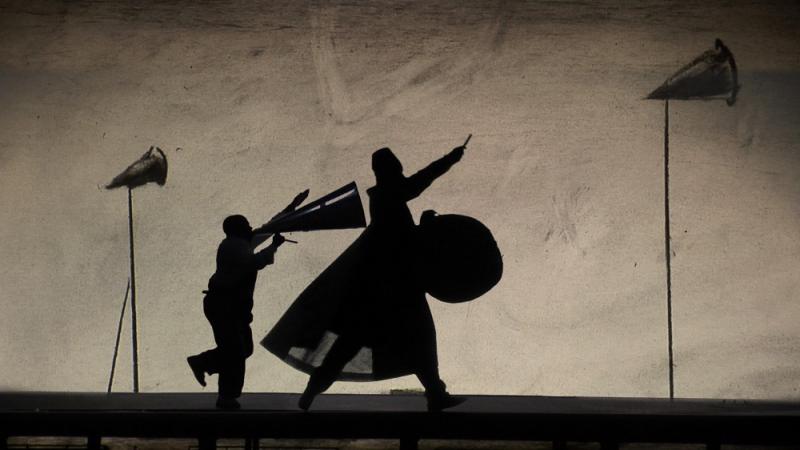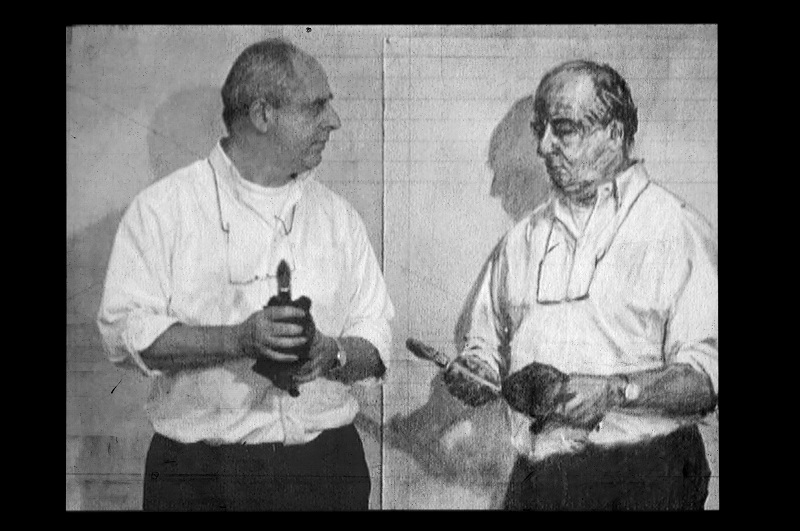William Kentridge: Thick Time, Whitechapel Gallery | reviews, news & interviews
William Kentridge: Thick Time, Whitechapel Gallery
William Kentridge: Thick Time, Whitechapel Gallery
A parallel universe revealed in immersive installations and monumental tapestries

Of all the mesmerising images in William Kentridge’s major Whitechapel show, the one that lingers most, perhaps, is that of the artist himself, now turned 60, hunched and thoughtful, wandering through the studio in Johannesburg where he lives and works. He paces, meditates over a "magical" cup of coffee, imagines, draws, tears paper, works, adjusts, observes, directs – all in the gentle manner of a Buster Keaton-style silent film star.
The artist’s brush and pigment take many forms in this video installation of 2003: a feather duster, black coffee dribbled from a pot, smudgy charcoal – all animated by the artist’s omnipotent gesture. In one short film, Kentridge’s wife, Anne – as naked muse and model – follows him unseen. In another, the artist catches torn pieces of paper that fly into his hands, reassembling to form a life-size drawing of himself. Now – this most cerebral of artists – becomes both bemused witness and preoccupied protagonist.
 The "thick time" of the exhibition is, in fact, a dimension where time has been stopped, reversed, fragmented, looped – even "refused" – using multi-media installations and experiments with mime, dance, music, tapestry, film, book and stage design. This cross-disciplinary environment has hugely enriched Kentridge’s work ever since the early 2000s. Radical mime, for instance, which Kentridge studied in Paris in the 1980s, has led him to ask what is the impulse behind a gesture, a drawing, the start of a mark. His answer always deploys his characteristic graphic brush technique, which continues in the radical figurative tradition of Goya, Grosz, and Kollwitz with its expressive splatters and unerring black line. Now dancers, scientific and cinematic pioneers, and musicians, too, provide an equally dynamic means of expression. Kentridge, in particular, pays tribute to Georges Méliès, the pioneer of various cinematic techniques such as animation, time-lapse and stop-motion photography, and "day for night" (pictured above right: 7 Fragments for Georges Méliès, Day for Night and Journey to the Moon, 2003).
The "thick time" of the exhibition is, in fact, a dimension where time has been stopped, reversed, fragmented, looped – even "refused" – using multi-media installations and experiments with mime, dance, music, tapestry, film, book and stage design. This cross-disciplinary environment has hugely enriched Kentridge’s work ever since the early 2000s. Radical mime, for instance, which Kentridge studied in Paris in the 1980s, has led him to ask what is the impulse behind a gesture, a drawing, the start of a mark. His answer always deploys his characteristic graphic brush technique, which continues in the radical figurative tradition of Goya, Grosz, and Kollwitz with its expressive splatters and unerring black line. Now dancers, scientific and cinematic pioneers, and musicians, too, provide an equally dynamic means of expression. Kentridge, in particular, pays tribute to Georges Méliès, the pioneer of various cinematic techniques such as animation, time-lapse and stop-motion photography, and "day for night" (pictured above right: 7 Fragments for Georges Méliès, Day for Night and Journey to the Moon, 2003).
There are six large works to explore in the Whitechapel show, dating from 2003-2016, including two immersive video installations that have never been exhibited previously in the UK. Each work represents a personal odyssey into the many different arenas that fascinate and intrigue Kentridge. In The Refusal of Time, 2012 (main picture), a tour de force presented in the downstairs galleries, the process of art becomes analogous to the process of science, complete with elephantine bellows, swinging dance rhythms, pulsing music, clocks, maps and giant metronomes, driven by "pumped" impulses. Within minutes we become mesmerised by the images and sounds that bombard us – the ritualised animated sequences of dancers and a carnival band, film clips, the tramp of human progress and displacement, black-and-white stills and sketches of imagined scientific laboratories, while fragments of a Kentridge lecture are conveyed through giant megaphones. At the nub of the various scientific "conversations" that served as inspiration, is the mid-19th century discovery of the speed of light and Felix Eberty’s expansion of that discovery which postulated all of space as "a universal archive of images from the past". "Near a star 2,000 light years away", as he put it, one could see "Jesus Christ on his cross … With each breath we pump out our images and transmit ourselves, and traces of ourselves".
 Elsewhere, Kentridge follows in the footsteps of the Old Masters Rubens and Raphael, producing monumental mural-scale tapestries using a grand European equestrian theme. But here, distinctly un-heroic horses, designed from collages and drawings, gallop across ancient maps of southern Europe and Italy’s Abruzzo region, or rear over dejected foot soldiers (pictured above: Streets of the City, 2009). Here militarism becomes an absurdist symbol of exploitation. Kentridge is fascinated by tapestry, a form that was invented by the Ancient Greeks, but which he sees as closely related to a modern-day pixelated image, with its warp and weft. Yet here, every stitch, made from goat's yarn, represents a human decision. Since 1976, he has also worked in theatre, puppetry and opera, and the Whitechapel show include his recent designs for Alban Berg’s Lulu, (opening at the ENO on 9 November) complete with his own "collaged" musical score (incorporating Schwitters, Webern and Schoenberg).
Elsewhere, Kentridge follows in the footsteps of the Old Masters Rubens and Raphael, producing monumental mural-scale tapestries using a grand European equestrian theme. But here, distinctly un-heroic horses, designed from collages and drawings, gallop across ancient maps of southern Europe and Italy’s Abruzzo region, or rear over dejected foot soldiers (pictured above: Streets of the City, 2009). Here militarism becomes an absurdist symbol of exploitation. Kentridge is fascinated by tapestry, a form that was invented by the Ancient Greeks, but which he sees as closely related to a modern-day pixelated image, with its warp and weft. Yet here, every stitch, made from goat's yarn, represents a human decision. Since 1976, he has also worked in theatre, puppetry and opera, and the Whitechapel show include his recent designs for Alban Berg’s Lulu, (opening at the ENO on 9 November) complete with his own "collaged" musical score (incorporating Schwitters, Webern and Schoenberg).
The maps reveal Kentridge as the great bibliophile – or, conversely, as he puts it "destroyer of books". In Second Hand Reading, 2013, the pages of dictionaries become frames for hundreds of drawings, their form enabling flip animations, their texts over-written with slogans, their original purpose still legible. Kentridge is fascinated by the thousands upon thousands of books that have been made redundant by technology – particularly dictionaries, lexicons and encyclopaedias ("gorgeous books that no-one is every going to look at"). Their paper – particularly pre 1830s – is the perfect receptacle for his art. One of the many slogans that deface the pages "Massacre under the grass", provides a shorthand for the way memories are buried; only traces remain, (barely perceptible, in this case, in changes in vegetation). "We have to make the work of describing what happened", says Kentridge. It is the artist who "marks their existence". Thick Time is rich in deep thought and stirring imagination – and time vividly spent.
rating
Share this article
The future of Arts Journalism
You can stop theartsdesk.com closing!
We urgently need financing to survive. Our fundraising drive has thus far raised £49,000 but we need to reach £100,000 or we will be forced to close. Please contribute here: https://gofund.me/c3f6033d
And if you can forward this information to anyone who might assist, we’d be grateful.

Subscribe to theartsdesk.com
Thank you for continuing to read our work on theartsdesk.com. For unlimited access to every article in its entirety, including our archive of more than 15,000 pieces, we're asking for £5 per month or £40 per year. We feel it's a very good deal, and hope you do too.
To take a subscription now simply click here.
And if you're looking for that extra gift for a friend or family member, why not treat them to a theartsdesk.com gift subscription?
more Visual arts
 'We are bowled over!' Thank you for your messages of love and support
Much-appreciated words of commendation from readers and the cultural community
'We are bowled over!' Thank you for your messages of love and support
Much-appreciated words of commendation from readers and the cultural community
 Kerry James Marshall: The Histories, Royal Academy review - a triumphant celebration of blackness
Room after room of glorious paintings
Kerry James Marshall: The Histories, Royal Academy review - a triumphant celebration of blackness
Room after room of glorious paintings
 Folkestone Triennial 2025 - landscape, seascape, art lovers' escape
Locally rooted festival brings home many but not all global concerns
Folkestone Triennial 2025 - landscape, seascape, art lovers' escape
Locally rooted festival brings home many but not all global concerns
 Sir Brian Clarke (1953-2025) - a personal tribute
Remembering an artist with a gift for the transcendent
Sir Brian Clarke (1953-2025) - a personal tribute
Remembering an artist with a gift for the transcendent
 Emily Kam Kngwarray, Tate Modern review - glimpses of another world
Pictures that are an affirmation of belonging
Emily Kam Kngwarray, Tate Modern review - glimpses of another world
Pictures that are an affirmation of belonging
 Kiefer / Van Gogh, Royal Academy review - a pairing of opposites
Small scale intensity meets large scale melodrama
Kiefer / Van Gogh, Royal Academy review - a pairing of opposites
Small scale intensity meets large scale melodrama
 Jenny Saville: The Anatomy of Painting, National Portrait Gallery review - a protégé losing her way
A brilliant painter in search of a worthwhile subject
Jenny Saville: The Anatomy of Painting, National Portrait Gallery review - a protégé losing her way
A brilliant painter in search of a worthwhile subject
 Abstract Erotic, Courtauld Gallery review - sculpture that is sensuous, funny and subversive
Testing the boundaries of good taste, and winning
Abstract Erotic, Courtauld Gallery review - sculpture that is sensuous, funny and subversive
Testing the boundaries of good taste, and winning
 Edward Burra, Tate Britain review - watercolour made mainstream
Social satire with a nasty bite
Edward Burra, Tate Britain review - watercolour made mainstream
Social satire with a nasty bite
 Ithell Colquhoun, Tate Britain review - revelations of a weird and wonderful world
Emanations from the unconscious
Ithell Colquhoun, Tate Britain review - revelations of a weird and wonderful world
Emanations from the unconscious
 Rachel Jones: Gated Canyons, Dulwich Picture Gallery review - teeth with a real bite
Mouths have never looked so good
Rachel Jones: Gated Canyons, Dulwich Picture Gallery review - teeth with a real bite
Mouths have never looked so good
 Yoshitomo Nara, Hayward Gallery review - sickeningly cute kids
How to make millions out of kitsch
Yoshitomo Nara, Hayward Gallery review - sickeningly cute kids
How to make millions out of kitsch

Add comment